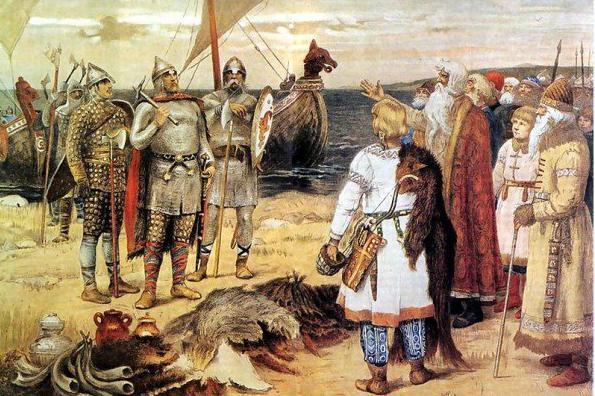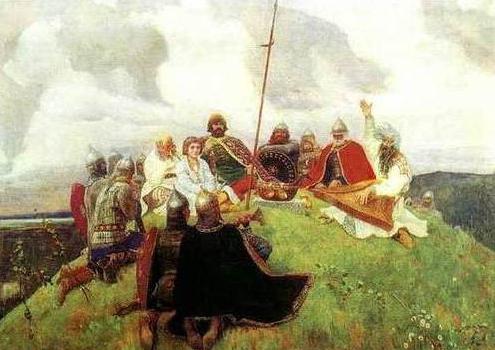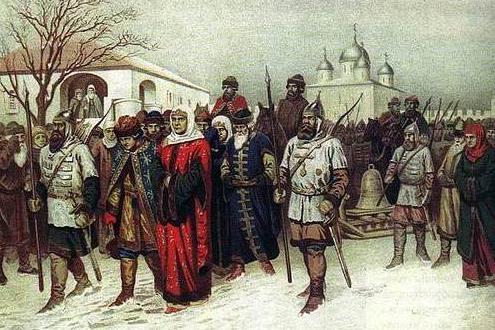Rurik (reign 862–879) - a famous Slavic prince with Varangian roots. The founder of the Rurik dynasty, who for many centuries ruled Russia. One of the most mysterious historical figures: many facts from his biography still remain a mystery behind seven seals.
Childhood and youth
The exact date of birth of the prince is unknown. Many historians suggest that this happened between 806 and 808 years in the Baltic city of Rarog. The Danish king Gottfried, who attacked these lands, hanged Rurik's father - Prince Godolyub. His mother, Umila, the daughter of Gostomysl, left her home with her young children and fled to a foreign land. When the future prince grew up, he and his brother were baptized at the court of the Frankish king, received titles and lands from him as a reward. In fact, he became the ruler of territories along the Elbe that belonged to his father, but only as a vassal.
The empire of the Franks at that time was tormented by civil strife. As a result of another military conflict, Rurik lost his land. Offended by the king, he went into the Varangian squad. Since then, he hated everything that was connected with this person and the state he ruled. In the favor of the prince was even a religion professed by the Franks. Being baptized, Rurik in every way violated the shrines of faith, so the people nicknamed him "an ulcer of Christianity."
Origin
Rurik (reign of 862–879) left a noticeable mark on history. But even those who consider him a real person are not really aware of the origin of this person. Historians supporting Norman theory say: Rurik and his wife are purebred Vikings who came from Scandinavia. To prove their innocence, they pay attention to the etymology of the name of the prince, linking him with the Latin "rex" - king, ruler. And perhaps this is true, because today the name Rurik is widespread precisely in the Scandinavian countries: Sweden and Finland.

Adherents of the West Slavic theory are sure that the roots of Rurik originate from the tribe of encouragement, who called themselves regresses - falcons. And they refer to the "Tale of Bygone Years", which says: in 862, the Krivichi and the Ilmen Slavs failed to agree among themselves and choose a single ruler. To avoid unnecessary bloodshed, they turned to their Slavic brother Rurik. He and his brothers arrived in Novgorod and ascended the throne: Rurik’s foreign and domestic policy was of a military nature. Some historians claim that the prince began to rule with Staraya Ladoga, and Novgorod was built by him only a few years later. This theory is confirmed by the archaeological find "Rurikovo settlement".
Rurik's domestic policy (briefly)
In such a difficult matter as the management of a great power, the prince made the main emphasis on strengthening his lands, gaining authority and respect. He was really feared and revered, because in the minds of ordinary people he was a formidable and strict prince, Rurik’s domestic policy was the same. The table below shows the main directions of state power of Rurik.
| Field of activity | date | Essence |
| Land expansion | 862–864 | Joining the Principality of Murom, Smolensk and Rostov |
| Fighting Internal Enemies | 864 | Suppression of rebellion organized by Vadim the Brave |
The uninvited guest in the person of Rurik caused discontent of local boyars and nobles, who themselves wanted to occupy the throne. Therefore, outbreaks of uprisings continually arose in different parts of the principality, but the ruler instantly with his mighty hand suppressed the rebellions of the indignant. He also continued to capture new Russian cities and neighboring tribes: thus Rurik got right up to Kiev itself, where Dir and Askold ruled.
Foreign policy
Once in the capital city of Kiev, the prince was fascinated by his beauty and power. He laid eyes on the capital of Russia, so the whole foreign policy of Rurik was subsequently aimed at capturing this tidbit. The table shows us how the so-called personal relations developed between the prince and Kiev.
| Field of activity | date | Essence |
| Peace Treaty between Rurik, Deere and Askold | 864 | The prince tried to secure the southern borders of the state, as it was demanded at that time by his foreign policy |
| War with Askold | 866–870 | The world did not last long. Askold began a campaign to the north and encroached on the lands that belonged to Novgorod. In a protracted war, Rurik defeated Askold's army, but Kiev did not capture |
| The conclusion of an alliance with Western tribes | 873–879 | The main goal of the ceasefire is to join forces to capture Kiev |
Foreign and domestic policy of Rurik was justified. He was one of the first to declare Russia on the world stage.
Unfortunately, the story of Rurik ends in 879. Further, the baton is picked up by
Prince Oleg, nicknamed the people by the Prophet, who actively inherits the rule of Rurik and realizes all the bold plans of his predecessor.
Followers
Foreign and domestic policy of Rurik was aimed at enhancing the power of all the Russian lands included in the principality. By 870, two unions had been created: the Southern Union, headed by Kiev, and the Northern Union, with its center in Novgorod. In the first city Askold and Deer ruled, in the second - Rurik. Dying, he put the reins in the hands of a distant relative of Oleg. He also entrusted him with custody of his little son Igor, who later became the Grand Duke.

Oleg managed to conquer the tribes of streets and Drevlyans. He annexed Kiev to Russia, establishing a pagan cult there. Then he went to Byzantium and signed a lucrative agreement that expanded the sphere of influence and opened up new opportunities for Russian merchants. Russia has become a full partner of the Empire. After Oleg, the son of Rurik, Igor, entered the throne. This period of time was turbulent: revolts and uprisings arose. But the prince acted much tougher than his predecessor: he constantly crushed popular protests, thereby strengthening centralized power.
Rurik: role in history
During his reign, Russian lands expanded significantly due to the conquered Finnish territories. The structure of Russia also included the tribes of the Eastern Slavs. Now all these peoples had a common religion, language and culture, traditions and customs. This was the first impetus to unite these communities into a single state with a full ruler and a clear hierarchy. Rurik did not become such a sovereign. But he created all the conditions for translating this dream into reality. It was with him that the creation of Kievan Rus began, the construction of large cities within it, and the improvement of the lives of ordinary people. Rurik's foreign and domestic policies flourished. The history of the glorious family of the Rurikovich, the first dynasty of autocrats in the history of Russia, started with him.

Rurik’s life is the success story of a simple person, a stranger, who not only seized power, but also managed to hold it in his hands and strengthen the influence of the state on the political map of the world. It was this prince who laid the foundation of a powerful and powerful power, which to this day is Russia.